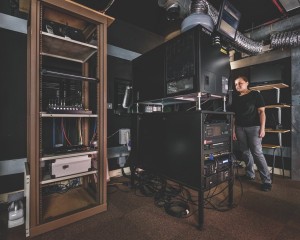The Projection Project
For The Projection Project two particular activities stand out in this regard. The first is The Projectionists, an exhibition of photographs by Richard Nicholson (richardnicholson.com), one of our project partners, which was first exhibited in Birmingham during the 2016 Flatpack Festival (some of Richard’s photographs illustrate this article). These photographs depict cinema projectionists working in some of the few remaining projection boxes in the UK that still show analogue film. They register the end of an analogue way of working. However, Nicholson chose to use a high definition digital camera as his preferred photographic tool. Again, this was partly practical: the low levels of light that characterise projection boxes could be more easily accommodated through the use of a digital camera. For the project team, however, this methodological paradox is emblematic of the work that we are doing.
This fed even more clearly into the work that has been put into developing the Virtual Projection Box (VPB). As the name suggests, this is a digital space, housed within the Projection Project website (projectionproject.warwick.ac.uk) that gathers together a curated selection of material that has been discovered or collected during the research. The VPB replicates the geographical layout of a projection box, with the space broken down into various ‘hotspots’, each of which is thematically (and spatially) related to the part of the box, machine or technology that it is linked to. So the digital projector hotspot contains material pertaining to digital projection and the transition to digital; the sound rack describes the process of dealing with sound in cinemas; the corner with the kettle and the microwave and the fridge explores the domestic routines and personal stories of projectionists.

Projectionist Rachel Dukes, Midlands Arts Centre, Birmingham. Part of The Projectionists exhibition. (Photo by Richard Nicholson)
The digital tools available have therefore allowed us to transform our research material, which might in its raw state be relatively dry for a non-academic audience, into an interactive and accessible virtual form. Three hour interviews can be split up and edited to form concise, informative clips. These can be placed side by side with other material (audio clips, online videos, archival documents) to create a kind of spatial montage that encourages resonances between materials to develop.
The processes of curating and editing have helped us to think again about the role that digital technologies play within our research topic, but also within our research. In curating the Virtual Projection Box links are spotted that may not otherwise have been made. Questions are asked about how sensitive or personal material should be treated; even though we can edit and shape material for clarity, and have permission from the participants to do so, should we?
Perhaps most importantly, we are utilising digital tools from the same genus as those that are responsible for the changes that are the subject of our research. We have to acknowledge this complicity with the processes that have led to the arrival of digital projection in cinemas, and the attendant human consequences that we are encountering. Reflecting on this as part of our research is a key concern and one that the Projection Project continues to address as it develops.
Dr Richard Wallace

 Learning on Screen
Learning on Screen